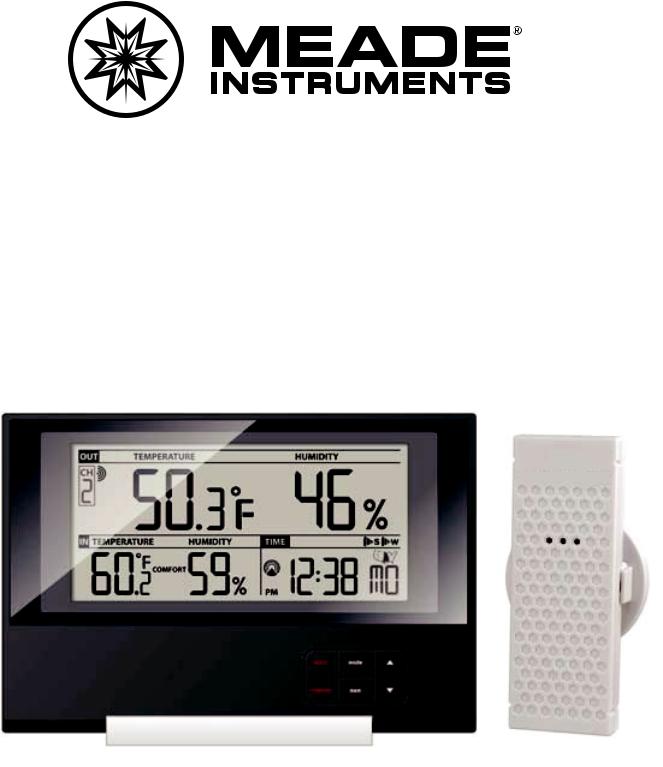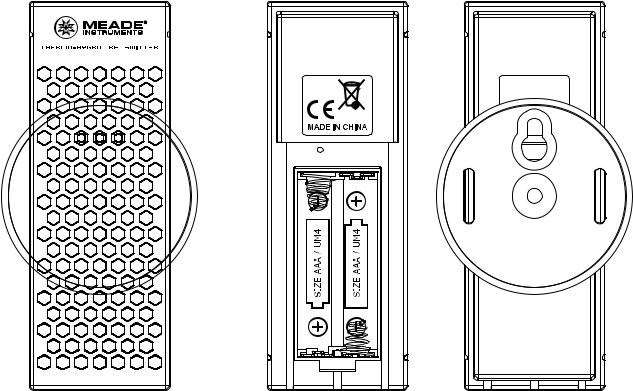Meade TE256W User Manual

TE256W
Slim Indoor/ Outdoor Thermo-Hygrometer with Atomic Clock
USER MANUAL
INTRODUCTION
Thank you for selecting a Meade Instruments Weather Forecaster! This device combines precise time keeping, monitoring and displaying of current temperature/ humidity data from up to three remote locations (additional sensors are required).
Meade Instruments is the world’s leading designer and manufacturer of telescopes for professional and amateur astronomers – famous for its innovative, high performance telescopes at affordable prices. Meade Instruments now brings that same passion for innovation and high performance to its own line of precision, feature rich weather stations.
Please read this instruction manual so that you can get the most enjoyment out of your Meade Instruments weather station.
In this package, you will find:
•One main unit (receiver)
•One single-channel remote sensor (transmitter)
•One user manual
Please keep this manual handy as it contains practical instructions, technical specifications and precautions.
2
INSTALLATION
Communications between the main unit (receiver) and the remote sensor (transmitter) is wireless. This allows you to greater flexibility in choosing the location of remote sensor. The remote transmits data up to 164 feet (50 meters) over an open, unobstructed area.
The remote sensor can be located either indoors or outdoors, allowing you chose where your data is obtained.
NOTE:
•It is critical to power the remote sensor BEFORE setting up the main unit.
•It is critical to power up and test communication between the remote sensor and the main unit BEFORE permanently mounting outside.
BEFORE YOU BEGIN
•We recommend using alkaline batteries for the remote sensor and the main unit. If outdoor temperatures regularly fall below 32°F (0°C), we recommend using lithium batteries.
•Avoid using rechargeable batteries. (Rechargeable batteries cannot maintain correct power requirements.)
•ALWAYS insert batteries into the remote sensor before the main unit.
•Insert batteries before first use, matching the polarity in the battery compartment.
•During initial set up, place the remote sensor close to the main unit.
•After reception is established (remote readings will be appeared on the main unit’s display), position the remote sensor and the main unit within the effective transmission range of up to 164 feet (50 meters).
•The main unit must be placed indoors.
NOTE:
•Avoid pressing any buttons on the main unit before the remote readings are displayed.
•Transmission or reception range may be affected by trees, metal structures, and electronic appliances, surrounding building materials and how the main unit and transmitter are positioned.
•Place the remote sensor so that it faces the main unit (receiver), minimizing obstructions such as doors, walls and furniture.
•Though the remote sensors are weather-resistant, they should be placed away from direct sunlight, rain or snow. The optimal location for the remote sensor outdoors is under the eaves on the north side of the building.
3

REMOTE TEMPERATURE AND HUMIDITY SENSOR (TS21)
FEATURES
•Remote data transmission to the main unit via 433 MHz frequency
•Single transmission channel
•Case can be wall mounted using accessory hanger
|
|
|
|
|
|
|
|
|
|
|
|
|
|
|
|
|
|
|
|
|
|
|
|
|
|
|
|
A. BATTERY COMPARTMENT |
|
|
|
|
||
|
|
|
|
|||
A |
B |
|||||
• Holds two AAA-size batteries
B. WALL-MOUNT RECESSED HOLE
• Mounts the remote sensor on the wall
BATTERY INSTALLATION
NOTE: When the temperature falls below freezing point 32F° (0C°), battery voltage will drop which may result in reduced the transmission range. For optimum performance in cold weather conditions, we recommend using lithium batteries.
NOTE: Install the batteries before mounting the remote sensor.
•Remove the screws from the battery compartment with a small Phillips screwdriver (not included).
•Install 2 “AAA” size batteries (not included) matching the polarities shown in the battery compartment.
•Replace the battery compartment door and secure the screws.
•Secure the remote sensor in the desired location.
MOUNTING
•The remote sensor can be mounted either horizontally or vertically.
•Use a screw, rather than a nail, to securely mount the sensor.
4
PLACEMENT
•The remote sensor should be placed under eaves or a similar location with free air circulation, sheltered from direct sunlight and extreme weather.
•Ideally, place the remote sensor over soil, rather than asphalt, which would cause false readings.
•Avoid placing the remote sensor near sources of heat, such as chimneys and heating elements.
•Avoid areas that collect heat from the sun and radiate heat, such as metal, brick or concrete structures, paving, and patios.
•The international standard for the valid air temperature measurements is 4 feet (1.25meters) above the ground.
OPERATION
Immediately after batteries are installed, the remote sensor will start transmitting a temperature and humidity data to the main unit.
MAIN UNIT
FEATURES
TIME
•Precise time and date set via signals from the US Atomic clock
•12 or 24 hour time format
•Manual adjustment of time and date
•Calendar displays in date with month format
•Weekday abbreviation in 7 languages English, German, French, Italian, Spanish, Dutch and Swedish
•Dual crescendo alarms with snooze
•Programmable ice warning alarm
TEMPERATURE AND HUMIDITY
•User-defined high/ low temperature alarm
•Indoor/ outdoor temperature and humidity in up to 3 remote locations (additional sensors required)
•Comfort level indicators (wet, comfort, dry)
•Minimum and maximum memories of temperature and humidity
•Auto scanning mode – 3 channels of outdoor readings will be displayed one by one automatically
5
